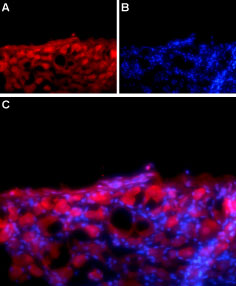Overview
- Peptide CKRRSETTAETFTE, corresponding to amino acid residues 43-56 of rat β1 subunit of voltage-gated Na+ channels (Accession Q00954). Extracellular, N-terminus.

 Western blot analysis of rat brain (lanes 1 and 4), mouse brain (lanes 2 and 5) and rat skeletal muscle (lanes 3 and 6):1-3. Anti-SCN1B (NaVβ1) (extracellular) Antibody (#ASC-041), (1:400).
Western blot analysis of rat brain (lanes 1 and 4), mouse brain (lanes 2 and 5) and rat skeletal muscle (lanes 3 and 6):1-3. Anti-SCN1B (NaVβ1) (extracellular) Antibody (#ASC-041), (1:400).
4-6. Anti-SCN1B (NaVβ1) (extracellular) Antibody, preincubated with SCN1B/Navβ1 (extracellular) Blocking Peptide (#BLP-SC041).
 Expression of NaVβ1 in rat DRGImmunohistochemical staining of adult rat dorsal root ganglion (DRG) using Anti-SCN1B (NaVβ1) (extracellular) Antibody (#ASC-041) followed by goat anti-rabbit-AlexaFluor-594 secondary antibody. A. NaVβ1 labeling (red) appears in the cell bodies of the DRG neurons. B. Nuclear staining using DAPI as the counterstain (blue). C. Merged image of A and B.
Expression of NaVβ1 in rat DRGImmunohistochemical staining of adult rat dorsal root ganglion (DRG) using Anti-SCN1B (NaVβ1) (extracellular) Antibody (#ASC-041) followed by goat anti-rabbit-AlexaFluor-594 secondary antibody. A. NaVβ1 labeling (red) appears in the cell bodies of the DRG neurons. B. Nuclear staining using DAPI as the counterstain (blue). C. Merged image of A and B.
 Expression of NaVβ1 in differentiated rat PC12 cellsCell surface detection of NaVβ1 in live and intact differentiated rat PC12 cells. PC12 differentiation was induced by Native mouse NGF 2.5S protein (>95%) (#N-100). A, C. Merge of NaVβ1 staining using Anti-SCN1B (NaVβ1) (extracellular) Antibody (#ASC-041), (1:50), (red) with live cell imaging. B, D. Merge of NaVβ1 staining (1:50), (red) with nuclear staining using DAPI as the counterstain.
Expression of NaVβ1 in differentiated rat PC12 cellsCell surface detection of NaVβ1 in live and intact differentiated rat PC12 cells. PC12 differentiation was induced by Native mouse NGF 2.5S protein (>95%) (#N-100). A, C. Merge of NaVβ1 staining using Anti-SCN1B (NaVβ1) (extracellular) Antibody (#ASC-041), (1:50), (red) with live cell imaging. B, D. Merge of NaVβ1 staining (1:50), (red) with nuclear staining using DAPI as the counterstain.
- Wu, L. et al. (2002) NeuroReport 13, 2547.
- Baker, M.D. and Wood, J.N. (2001) Trends Pharmacol. Sci. 22, 27.
- Lai, J. et al. (2003) Curr.Opin. Neurobiol 13, 291.
- Catterall, W.A. (2000) Neuron 26, 13.
- Chen, C. et al. (2002) Proc. Natl. Acad. Sci. U.S.A. 99, 17072.
- Schmidt, J.W. and Catterall, W.A. (1986) Cell 46, 437.
- Lopez-Santiago L. F. et al. (2006) J. Neurosci. 6, 7984.
Voltage-gated sodium channels (NaV) are essential for the generation of action potentials and for cell excitability.1 To date, nine NaV α subunits have been cloned and named NaV1.1-NaV1.9.2,3 Mammalian sodium channels are heterotrimers, composed of a central, pore-forming α subunit and two auxiliary β-subunits (NaV β-subunit).4
The NaV β-subunit gene family consists of four members: β1 (SCN1B), β2 (SCN2B), β3 (SCN3B), and β4 (SCN4B) having type I topology, containing an extracellular amino-terminus, a single transmembrane segment, and an intracellular carboxyl-terminus. They modulate channel gating, assembly, and cell surface expression in heterologous cell systems.5
NaV β-subunits are cell adhesion molecules of the Ig superfamily, which interact with extracellular matrix, transmembrane signaling, and cell adhesion molecules.5
In the adult central nervous system and heart, sodium channels are associate with β1-β4 subunits, whereas in adult skeletal muscle they are associate only with the β1 subunit.4,5 This association appears to be a late event in sodium channel biosynthesis.6
Application key:
Species reactivity key:
Anti-SCN1B (NaVβ1) (extracellular) Antibody (#ASC-041) is a highly specific antibody directed against an epitope of the rat protein. The antibody can be used in western blot, immunohistochemistry, immunocytochemistry, and live cell imaging applications. It has been designed to recognize NaVβ1 from human, rat, and mouse samples.
Applications
Citations
- Rat brain neurolemma lysate.
Murenzi, E. et al. (2017) Neurotoxicology 60, 260.
